On this page, we have made an effort to present all the shelf hanging methods that will most probably be interesting and useful for you.
Looking around the interior of your house, you will see that you are surrounded by a large number of shelves. By shelves we do not mean only those on the walls, but also the ones inside kitchen cabinets, different types of closets/wardrobes, bookcases, etc. There is a large number of shelf hanging methods (shelf supporting methods), and every woodworker should be familiar with as many of them as possible and know both their advantages and disadvantages. For each of the methods, there is an illustration to visually clarify it, along with a short text to provide you with additional explanation.
Shelves can be divided in various ways. In the first place, it is obvious that there are shelves that are mounted directly to the wall, and shelves that are found inside furniture pieces and installed between the sides.
Another way to divide shelves is according to their functionality, i. e., they can be fixed and adjustable. Fixed shelves, when mounted on some height between the cabinet sides, cannot be quickly and easily moved to some other height. Unlike the fixed ones, adjustable shelves can easily be moved to different heights and thus the distance between them is also regulated. It should be noted here that there is a price for this extra functionality. Most adjustable shelves do nothing to hold the cabinet sides together, i.e., they do not prevent sagging. If you make a tall piece of furniture with several shelves between the sides, we recommend that you include at least one fixed shelf (act as a stretcher) somewhere in the middle. In this way, you will further strengthen the construction and reduce the likelihood of sagging.
Sagging of the shelf
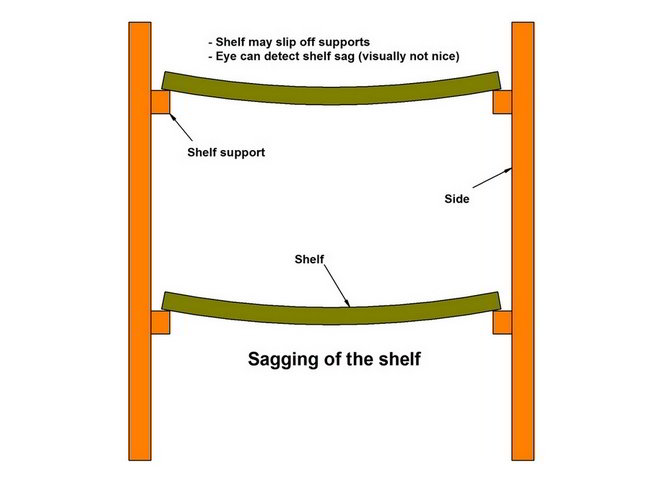
When deciding which shelf hanging method to use, you must bear in mind several important criteria:
- the weight of the shelf and the load on it;
- whether it is necessary for the shelf to be rigidly tied to the sides or not, i. e., to keep the sides or not (this is very important if you make a piece of furniture that is tall);
- whether you need an adjustable shelf;
- easy to create if you opt for non-commercial support;
- visibility of the joint;
- decorativeness ...
In this text, the shelf hanging methods are divided as follows:
- Shop-made ways to hang a shelf (Shop-made shelf hanging hardware) - this category includes shelf supports that you can make in your workshop
- Commercial ways to hang a shelf (Commercial shelf hanging hardware) - this category includes factory-made shelving hardware that can be bought at the hardware stores
- Woodworking joints suitable for supporting shelves - in this category you can see hanging methods where the shelf is put together with the sides using woodworking joints
- Decorative ways to hang a shelf - here various hanging methods are implied which, in addition to constructive features, have the ability to enrich the furniture design
- Ways to hang wall shelves – these are wall-mounting methods
Shop-made ways to hang a shelf
There’s no need to buy any commercial shelf hanging hardware, you can make them yourselves. Here you can see only some of the most commonly used shop-made ways to hang a shelf.
1. Cleat shelf support
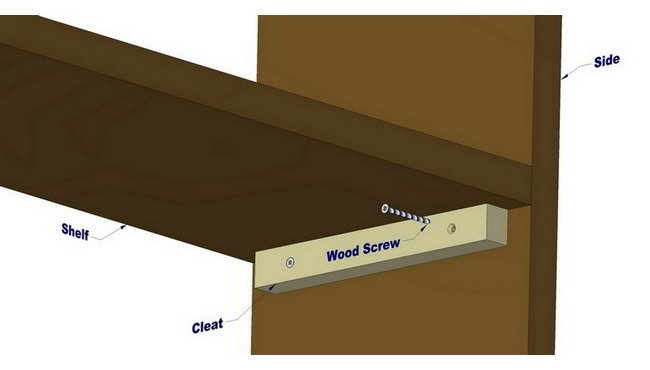
The connection between the shelf and the side using the cleat falls into permanent mounting methods. The cleat gives firmness to the construction if it is fastened both to the shelf and the side. It is possible to have an adjustable connection to the side - in that case, do not fix the cleat to the side with screws but use dowels instead. Of course, this requires drilling a series of matching holes (parallel rows of holes). The cleat is not a decorative connection, but a practical one because it can be quickly done and is also suitable for beginners. You can partially hide the cleat if you make it shorter than the width of the shelf.
2. Using a split cleat to hang shelves
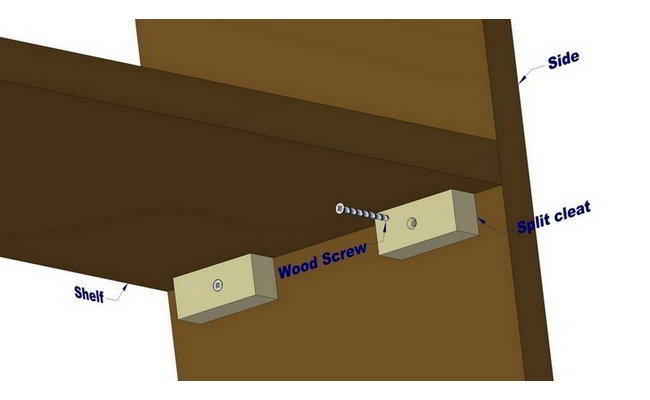
As you can see in the picture, this is exactly the same hanging method as the previous one, and the only difference is that here there are two smaller cleats instead of one.
3. Using a hidden adjustable cleat to hang shelves
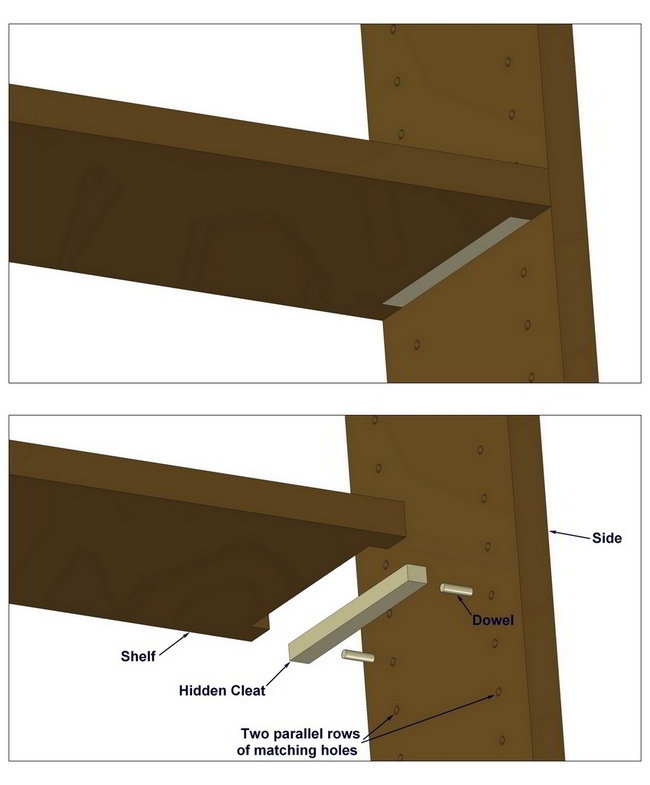
This is an invisible hanging method and can be adjusted if you drill two parallel rows of matching holes. Using an adhesive, this connection can serve as a medium-strength fixed shelf. The hidden cleat method is not suitable for putting up heavy-duty shelves.
4. Wooden shelf standards
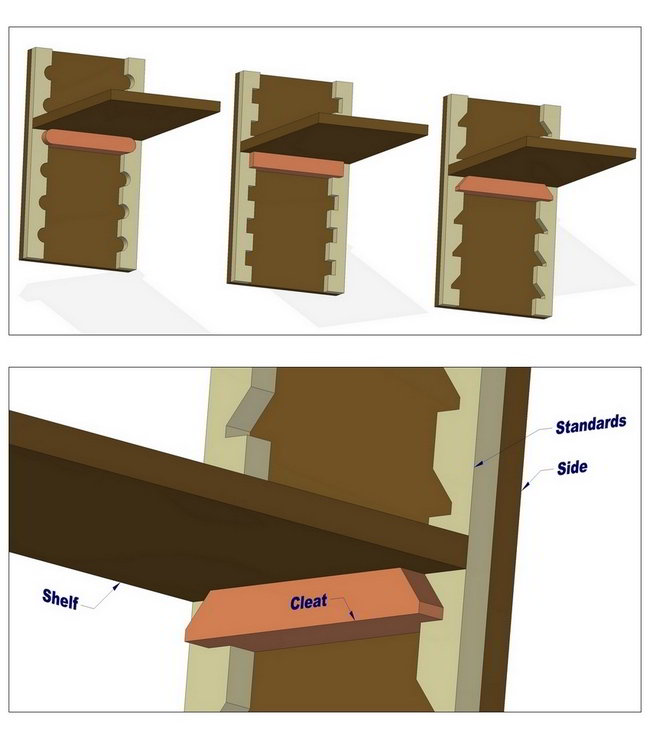
In the following picture, you can see three hanging methods called wooden standards. This type of shelf hanging can withstand heavy loads, and this is a good thing. However, there is also a bad thing - it does not hold the sides together. Another disadvantage is its visibility, although everything depends on individual taste, and quite a lot of people may find this type of shelf supporting attractive. Wooden standards are not difficult to produce, but they require precision and its making takes a long time. Cleats are always about twice as thick as standards.
5. DIY shelf pins
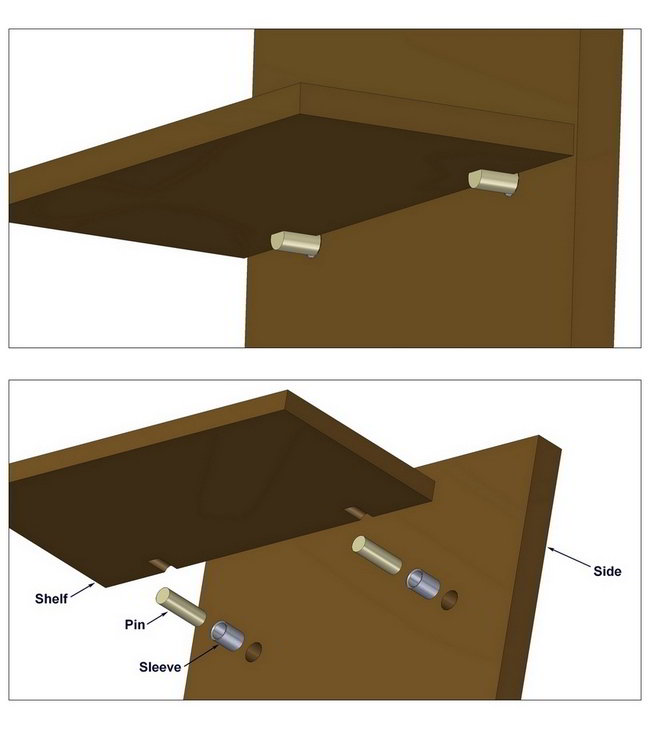
There’s no need to buy any shelf pins, you can make them yourselves! As you can see in the picture, it is enough to cut the brass rod (pin) and brass tube (sleeve) to a certain length. If you do not use the sleeve, the shelf pin is likely to deflect the wood over time. Don’t forget to make a chamfer on the inside edge of the sleeve to make it easier to insert the pin. The underside of the shelf can be notched to increase shelf stability. This technique for joining the shelf and the side can be used in hardwoods, softwoods, particleboard, MDF.
6. Tube shelf pins
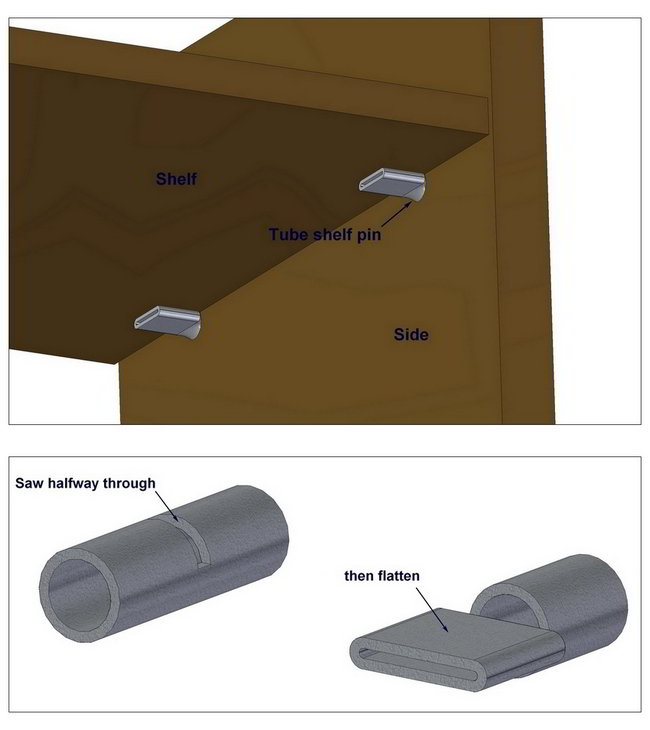
This is a diy variant of commercial shelf pins. They are not very visible, they are suitable for adjustable shelves and are very easy to make. Find a tube with the same diameter as the holes you have drilled in the sides, make a cut with a saw about 1/3 - halfway through, and then flatten the tube at one end using pliers or a hammer. This shelf supporting method does not prevent sagging.
- Commercial ways to hang a shelf
There are a lot of types of hardware for supporting shelves that are found at the hardware stores and on the Internet. Here you can see only some of the most commonly used and easily accessible at your local hardware store or on the Internet (enter the following keywords into the search engine: shelf hardware, shelf brackets, shelf supports, shelf pins, etc.). Commercial hardware is not used for corner joints on furniture, i.e., as a connection between the sides and the top/bottom. For this purpose, woodworking joints are used.
7. Shelf pins
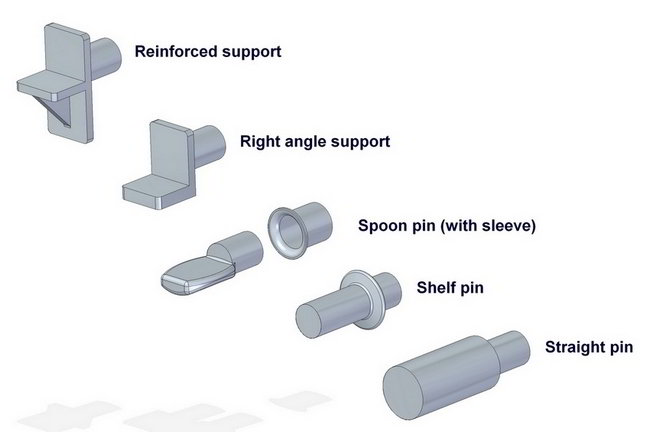
In the picture you can see several commercial variants of shelf pins (shelf pegs). There is a large number of different types of shelf pins (Reinforced support, Right angle support, Straight pin, Spoon pin...) which differ in shape, size, material and quality. They all allow the shelf to be adjustable if a series of matched holes is drilled. They have several drawbacks:
- they do not hold sides together, i.e., do not prevent sagging;
- in most cases they are made of low-quality plastic or metal;
- they are usually bought without a sleeve and are directly imprinted in the material; with no sleeve (or bushing), the material can be damaged over time, and the connection will become loose.
Shelf pins cannot withhold a heavy load on the shelf. If, however, the shelf is heavily loaded, it is necessary to use the sleeve.
8. Metal shelf standards
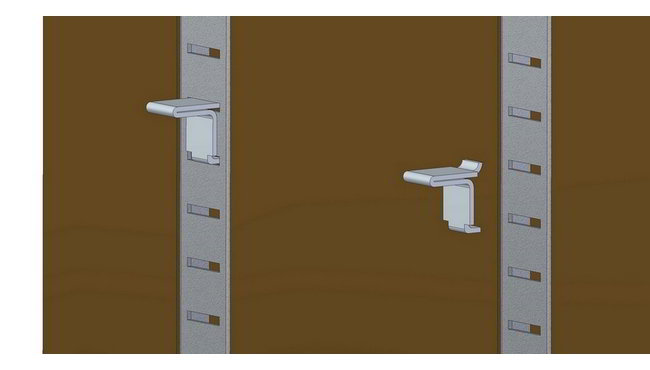
Metal shelf standards (standard with clip) are stamped steel lengths or brackets, perforated to accept mounting screws and shelf support clips.
Installation: run a pair of dadoes down each side and nail or screw shelf standards into place.
The disadvantages are that the shelf standards are not suitable for fine furniture because they are visible, and that they do not hold the sides together. The good features are that they are easy to install and adjustable. Metal shelf standards does not prevent sagging.
9. Angle Bracket
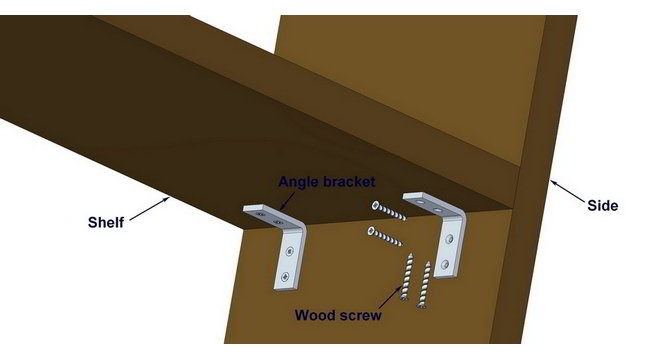
There is a large number of angle brackets on the market that you can use to support shelves inside cabinets or on the wall. They are visible, but their good side is that they give firmness to the construction, keeping the sides together. They are easily installed using screws. However, it is pointless to talk about their decorativeness, since this is one of the least aesthetically pleasing shelf hanging methods.
- Woodworking joints suitable for supporting shelves
There are many types of woodworking joints that you can use to hold the shelves between the sides in various pieces of furniture.
Most of them meet all the requirements, and some of them are also intended for tall furniture pieces and heavy loads on the shelves. Their choice depends largely on your experience and the way you work, the machines that you have, and how you want them to look like. Shelves for fine furniture are mainly installed with woodworking joints.
Woodworking joints that you can use to hold the shelves:
10. Biscuit joint
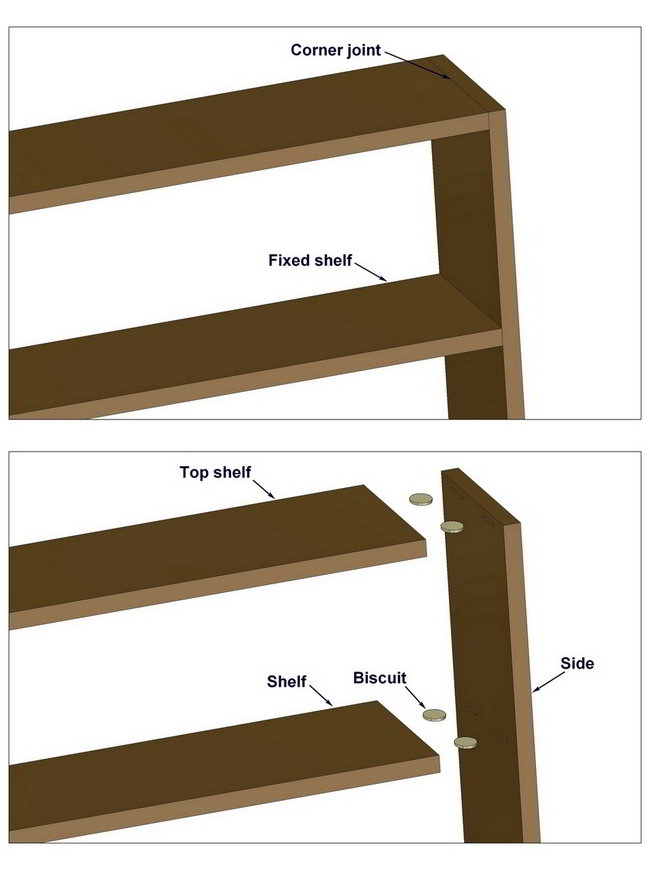
The biscuit joint can be used for both the corner joint and the fixed shelf. It is a medium-duty joint. Its good feature is that it holds the sides together, and its bad feature is that this connection is not suitable for heavy-duty shelving . With biscuits, shelves are easy to install, and another good feature is that they are invisible. Use at least two biscuits at each end of the shelf. This connection of the shelf and the sides is not adjustable.
11. Box joint
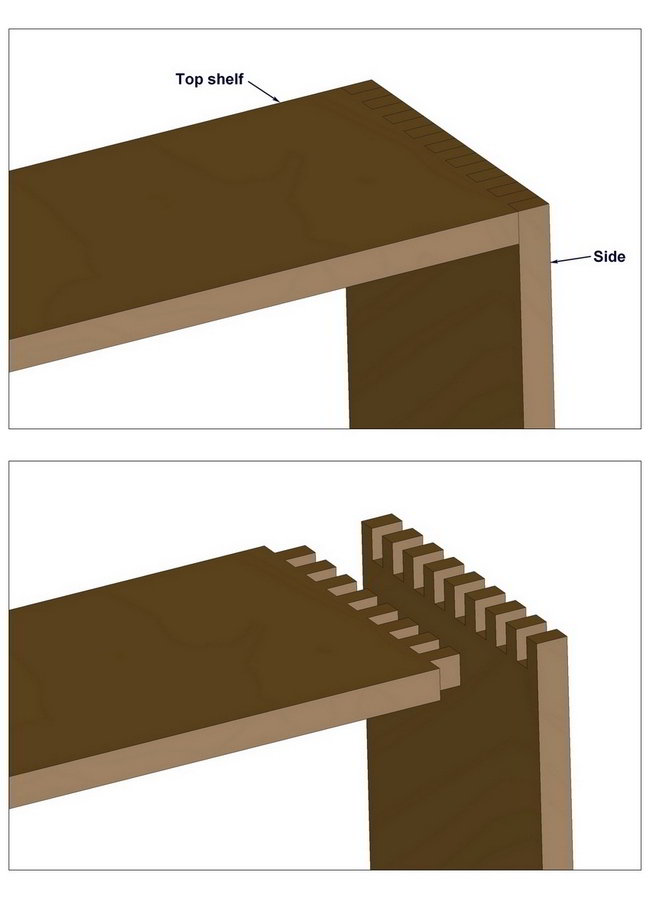
The box woodworking joint is used for connecting the side and the top or base shelf, i.e., as a corner joint. This is a visually beautiful joint which, if made well, can be very strong.
12. Dado joint
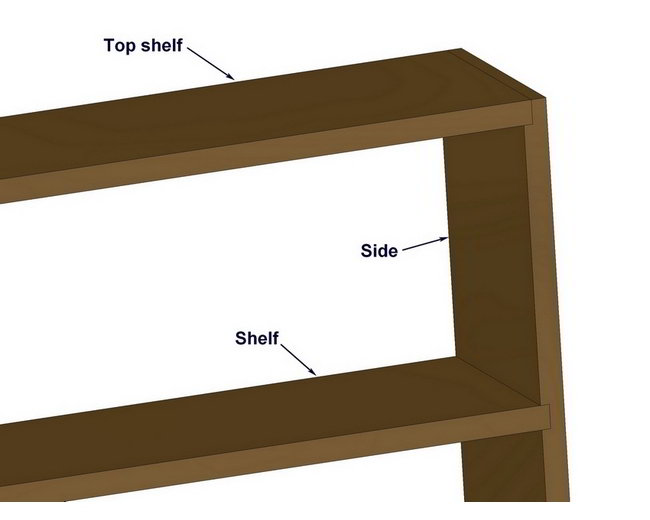
The dado woodworking joint is used for both fixed shelf and corner joint. It is very often used in practice, although it does not add much strength. When installing the shelf, an adhesive is used, and if you want to strengthen it, nails or screws have to be used. This way of connecting enables the shelf to withstand heavy loads, especially if you use some method to keep the ends of the shelves in the dado. This is a visible joint, but it can be easily hidden if it is stopped or covered by a face frame. The dado joint is not adjustable.
You can camouflage the dado joint if you make the shelf to be wider than the sides (see picture for a few examples). This solution is interesting because it can even slightly add to the beauty of the design.
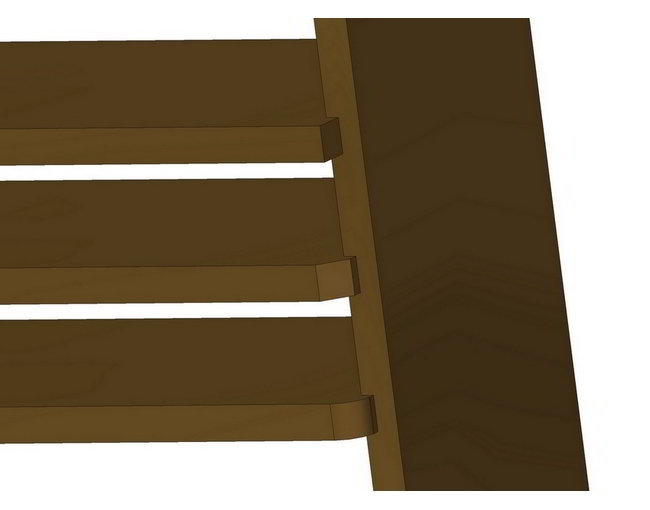
Rabbeted dado joint
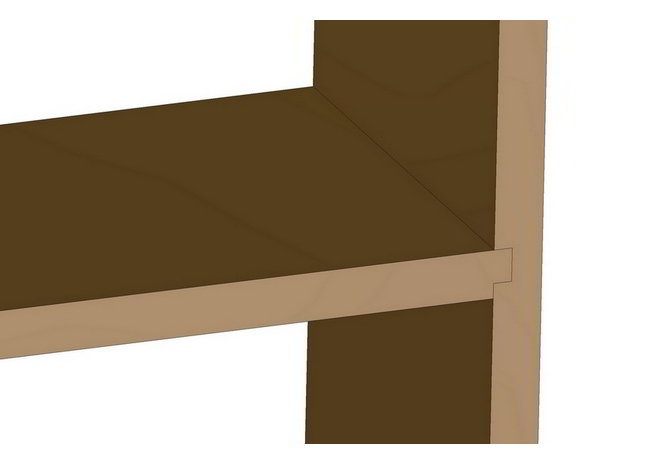
A slight variation of the previous method, whose main advantage is the ability to fit the joint more easily (especially if the shelf thicknesses are inconsistent).
- Stopped dado joint
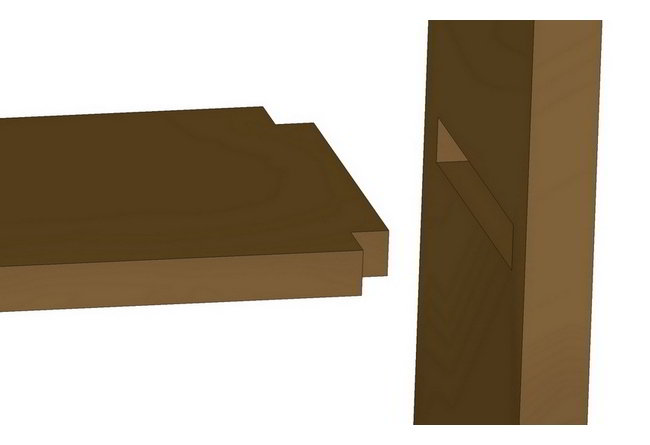
This is the invisible variant of the dado joint.
13. Dovetail joint
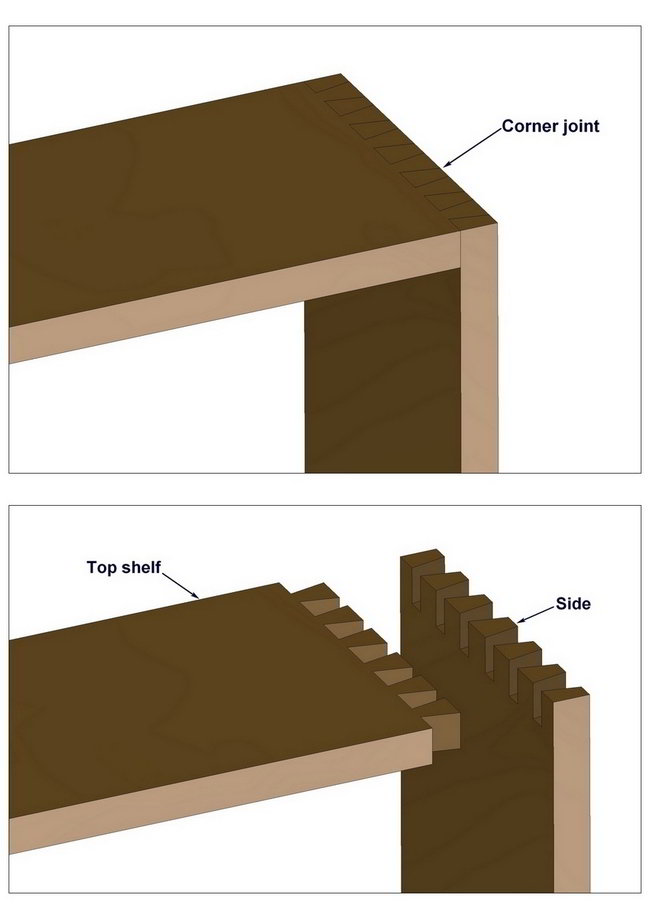
The connection of the shelf and the sides with dovetail woodworking joints is very strong and decorative. The dovetail joint is difficult to make, and it will lose both of its positive characteristic due to imprecise production. It is only used for corner joints when strength and traditional look are required. It is a very decorative joint that will put to the test your woodworking precision and experience.
14. Dowels
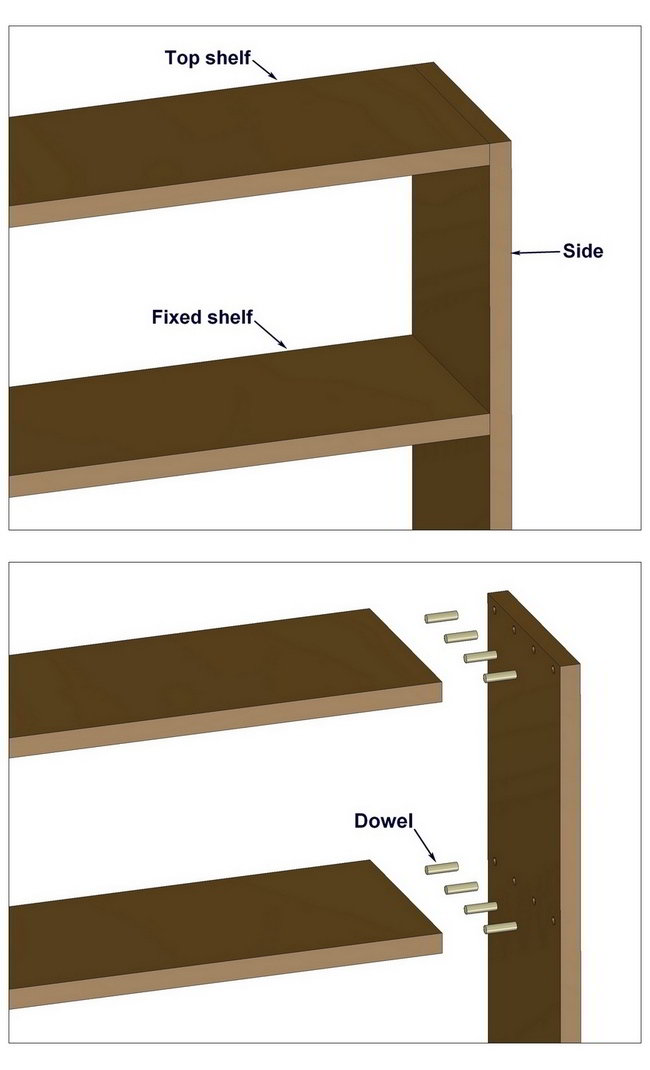
Dowels can also be used for corner joints (connection between the side and base or top) and for shelving (fixed shelf). Accuracy of hole placement and size is very important in the making of this joint. The dowel joint is a hidden, medium-strength joint.
In the following pictures, you can see two additional variants of joining shelves using dowels.
Dowels can replace commercial shelf pins.
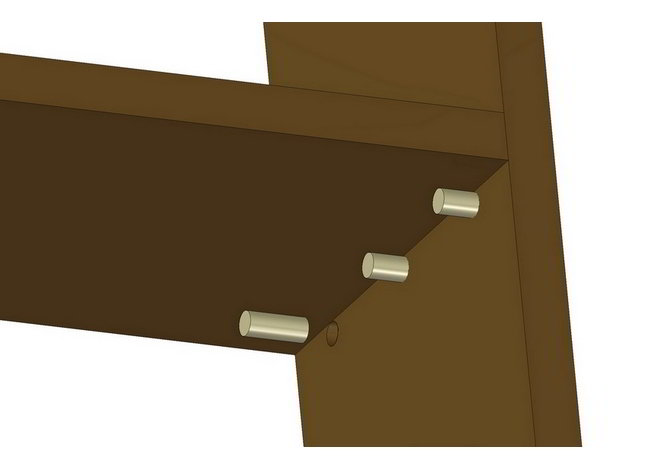
Dowels can serve to hang shelves when the sides are not boards.
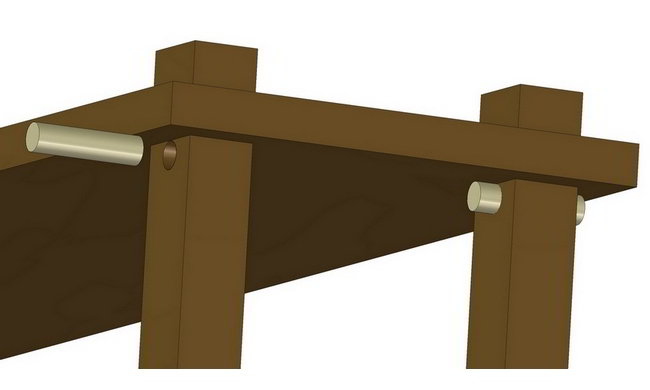
15. Through mortise and tenon joint
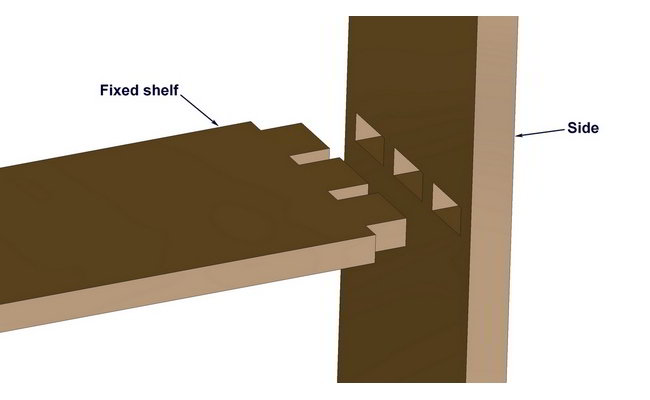
The mortise and tenon joint is good for a fixed shelf, but it cannot be used for the corner joint. There are several variants of this shelf-and-side connection such as the hidden stopped tenon or stub tenon. This connection is not adjustable, nor is it easy to create, but it withholds heavy loads and prevents sagging.
Through tenons joint can be wedged.
16. Keyed mortise and tenon joint
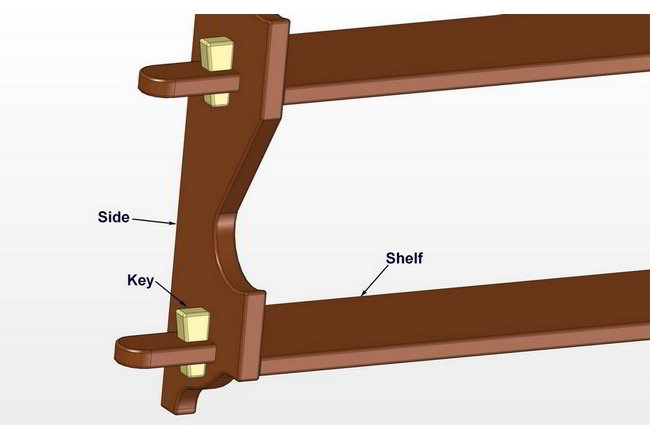
This shelf hanging method can be found on old wall shelves with sides. It is a traditional way of joining shelves and sides and provides high-strength structure that can withstand heavy loads and be visually appealing on various pieces of furniture (wal shelves, bookcases…).
17. Sliding Dovetail and Half Sliding Dovetail joint
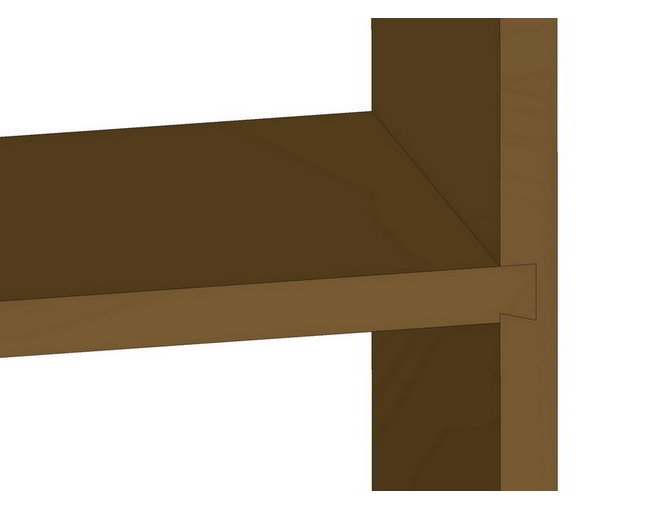
The sliding dovetail woodworking joint is suitable for fixed shelves. This is a very strong connection between the shelf and the side, and with the use of a quality jig it can be created rather quickly. In addition to keeping the sides together, this joining method can withstand a heavy load on the shelf. The following rule is applied to it, as well as to any dovetail woodworking joints: if not well executed, it loses both looks and strength. This joint is visible, but it can become invisible if it is stopped or covered by a face frame.
Half sliding dovetail joint shelf hanging method
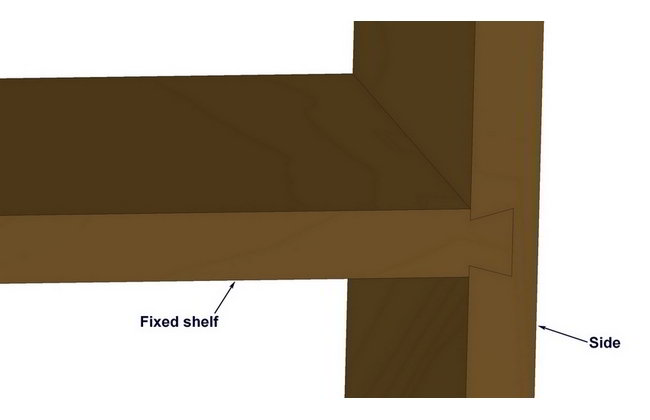
- Decorative ways to hang a shelf
When shelves and shelf supports get their turn while designing furniture, some of the most important criteria are: load capacity, appearance, adjustability, prevention of sagging ... Decorativeness of shelf supports in most cases is not important, but in case of open shelves, without any doors to hide them, their appearance can be considerably enhanced with decorative shelf supports. For this reason, you are presented here with decorative ways of how to join the shelves to the sides.
18. Decorative ceat
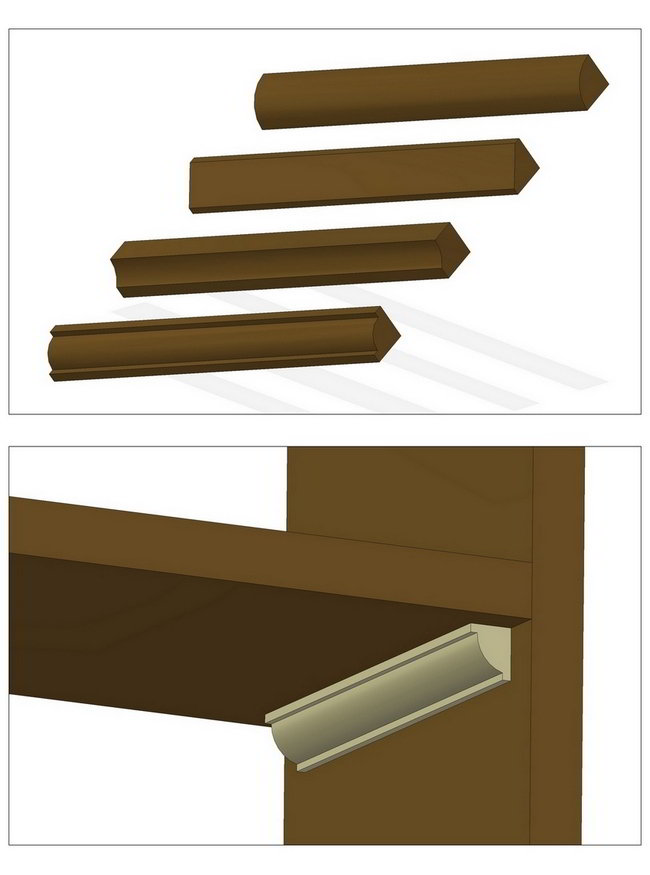
Most commonly, the cleat is a square-edged strip and, as we have already mentioned this type of joint, which is not decorative in itself. If you add details like a chamfer, roundover or molded edge to the cleat, the cleat can partially decorate the structure, i.e., it also gets a decorative function. This is an independent hanging method, so it doesn’t have to be combined with other methods.
19. Scroll Saw shelf Support
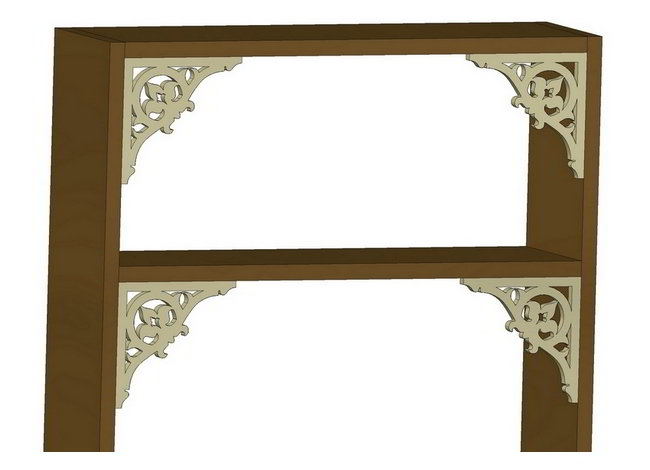
By using scroll saw technique you can cut out any shape from wood and attach it to the side and the front of the shelf bottom with dowels. This method serves only as a reinforcement and decoration, i.e., don’t use it independently, but together with another method such as dado, sliding dovetails, biscuit, etc. Scroll saw shelf support cannot be used with adjustable shelving systems. On our site there is a page where you can download a large number of patterns for scroll saw supports.
20. Creative decorative hanging methods
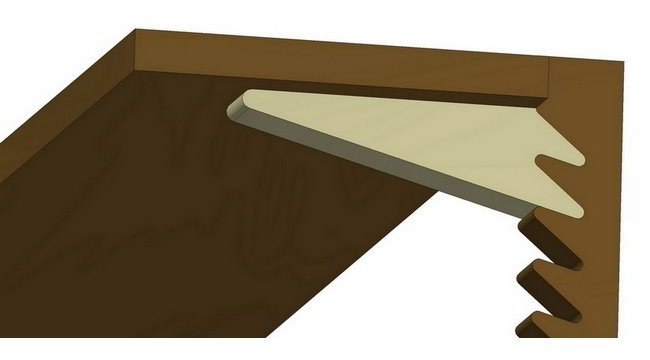
There are many more methods that you can see or design yourselves. It all depends on your creativity. Just take a look at the picture below, there is a very interesting decorative method that will surely attract the attention of many with their beauty and simplicity.
- Ways to hang wall shelves
So far, we have dealt with a large number of ways to hang shelves between the sides that are mostly used on furniture. One special category of shelves are wall shelves.
Today, for most of the wall mounting methods, it is common to drill a hole in the wall where an anchor and a screw should be placed. In this way, the screw is firmly put into the wall, and the shelf is then hung on the screw using various methods.
21. Plastic Anchor
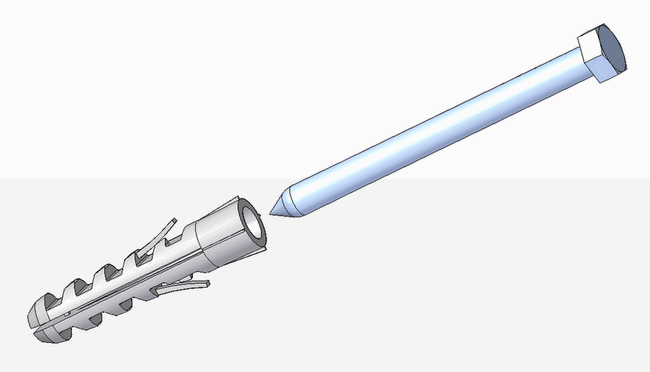
There are many furniture pieces, such as spice cabinets, wall cabinets, kitchen wall cabinets, wall shelves and the like, which have a portion on their construction (if not, reinforcements can be made) that is solid enough to make possible their mounting directly to the wall with screws and anchors. This is the simplest and most reliable variant of hanging.
22. Floating Shelves (Torsion Boxes)
In the following pictures you can see how you can hang your floating shelves on the wall.
Floating shelf installed with cleat
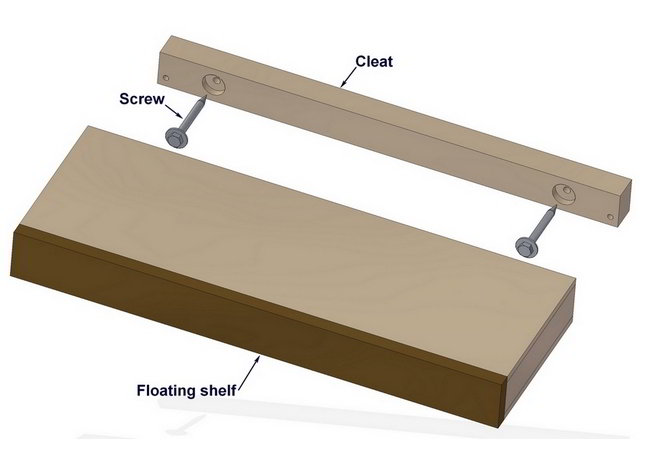
Floating shelf installed with French cleat
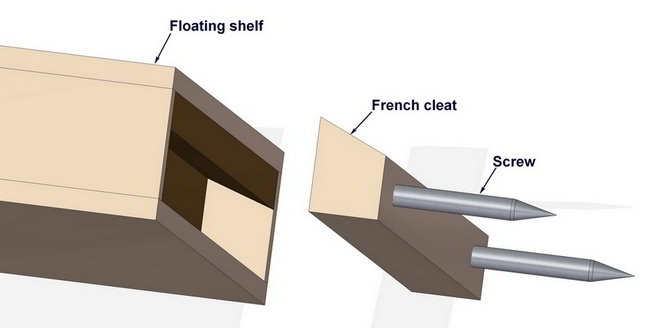
Floating shelf installed with aluminum angle
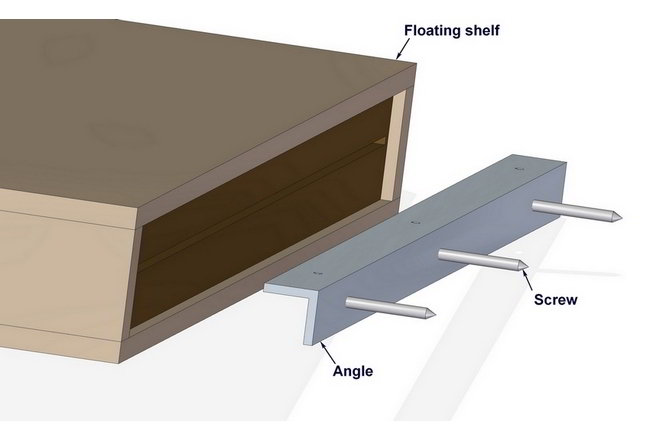
23. Brace Floating Shelf
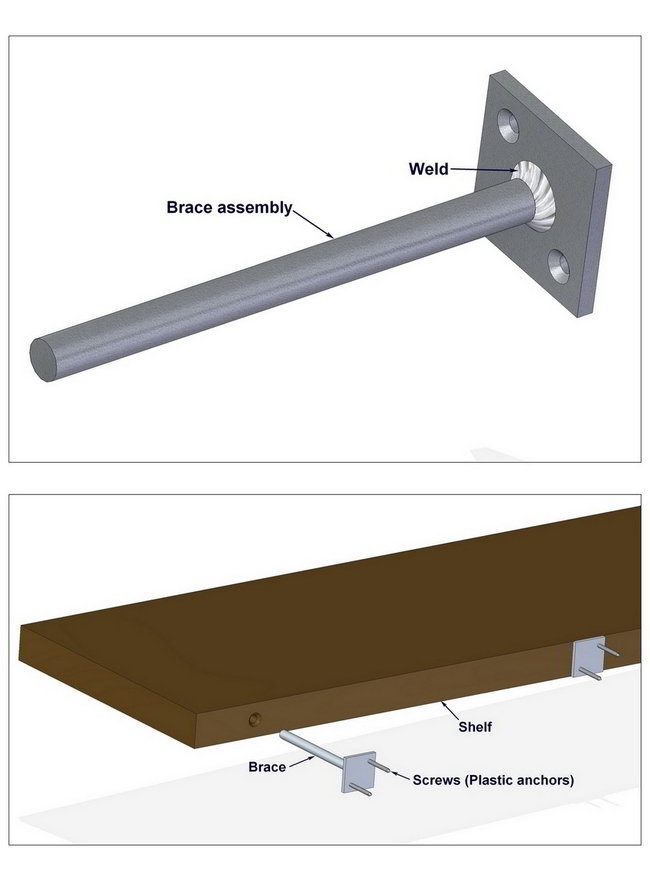
This is a type of commercial hardware that is used to hang floating shelves. If you have learned to weld, you can easily make one in your workshop.
24. Triangle Brackets
This is a very simple way to hang shelves. Make a wooden bracket in the shape of a right triangle. Fix it to the wall with anchors and screws, so that the upper side is horizontal. Fix the shelf to the upper side. In the picture you can see two ways of making triangle brackets. The first one is very simple using 3 slats and screws. The other one requires woodworking joints. Various woodworking joints are suitable for making triangle shelf brackets.
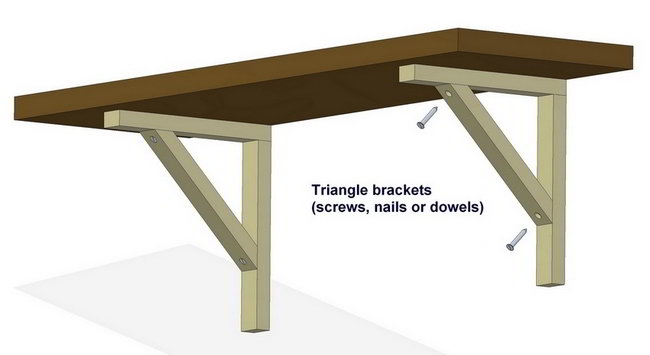
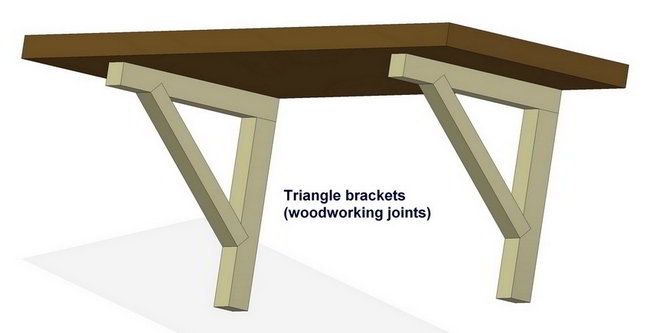
25. Keyhole Hanger with Screws
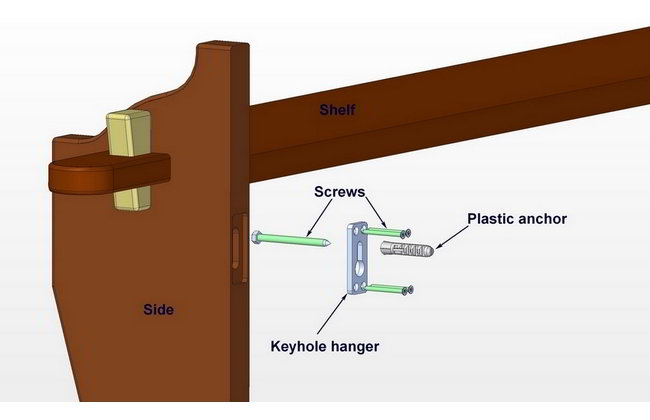
The keyhole hanger is a very simple type of shelf hanging hardware, and you can either make it in your workshop or buy it at the store. The keyhole hanger is a metal tile with little holes, through which you can fix it to a suitable place on the shelf construction, and a big hole in the shape of a keyhole that serves to hang the construction on a screw put into the wall. There are various variants of the keyhole hanger, and if something light is hung on the wall (a picture, a small shelf, etc.), you can even use a pull tab of drinking can as a keyhole.
26. Glass Shelf Supports
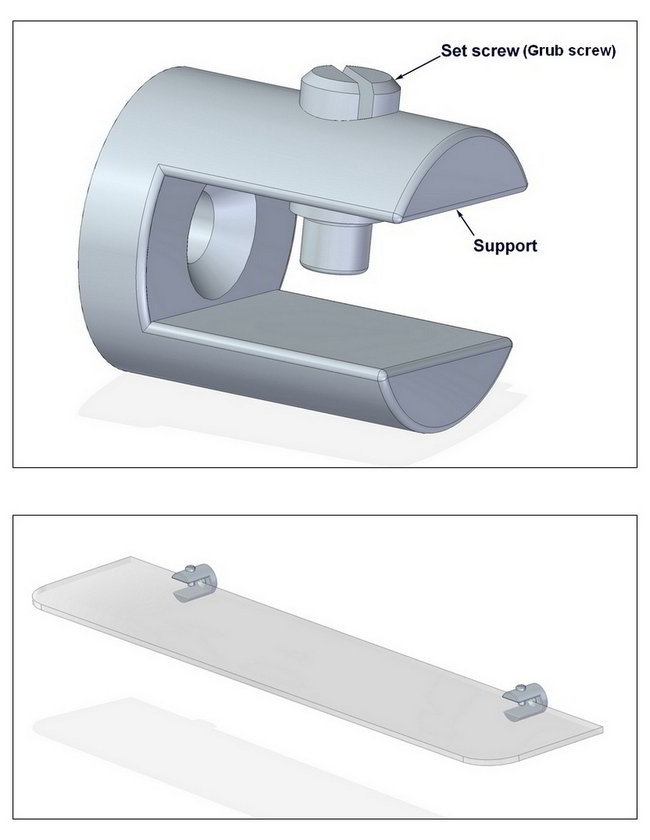
Glass shelf supports, as their very name suggests, serve to hang glass shelves. These can be most often found in bathrooms. As you can see in the picture, a screw and anchor are used to fasten the support to the wall and there is a groove and screw on it (usually grub screw). The shelf is placed in the groove and fixed in the support by tightening the grub screw. Since glass shelves are not designed for heavy loads, this is a satisfactory solution. You need to put the anchor completely into the wall or cut off the excess. If you don’t do this, the support will be able to spin on its axis and the shelf will be unstable. There are a lot of supports of this type, from the simplest ones as shown in the picture to the decorative ones. In any case, they are very visible and their aesthetics are very important.
27. Scroll Saw shelf Brackets
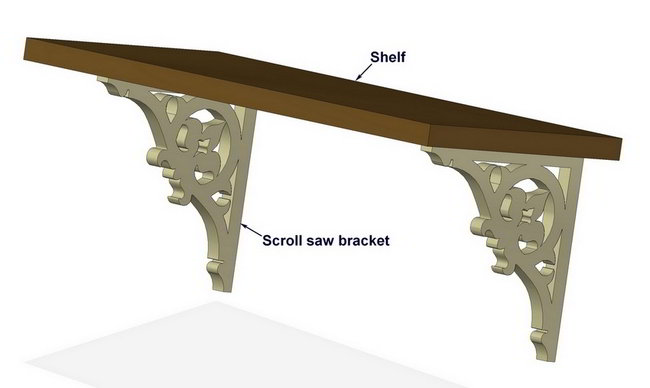
If a triangle bracket is made with the scroll saw technique, a beautiful decorative bracket will be obtained. Scroll saw brackets can be of various dimensions and shapes, and on our site there are several pages dedicated to them. Scroll saw brackets are fixed to the wall with screws and anchors, and a shelf is put up with screws or dowels. Scroll saw shelf brackets are very decorative but difficult to make.
28. Standard Shelf Bracket
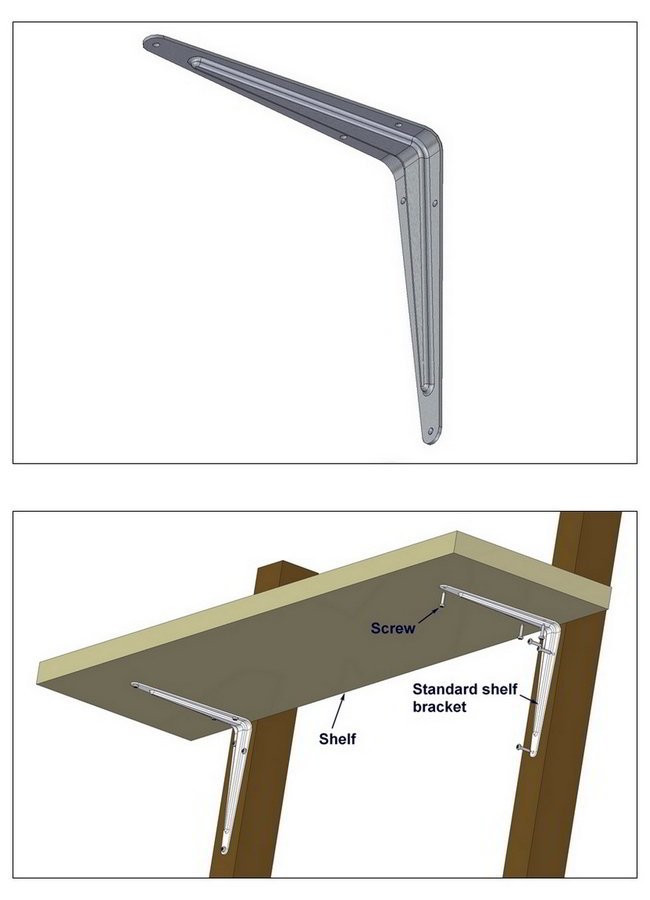
There is a plenty of shelf brackets that you can buy on the market. They are made of various types of metal and are generally considered a reliable and fast shelf hanging solution. They are fixed to the wall with screws and anchors. Usually they don’t look nice, so they should not be chosen at places where aesthetics are important, but rather where beauty is not a priority. Standard shelf brackets are a great solution because they are easy to install and, depending on their dimensions, can withstand large loads.
29. Wrought Iron Shelf Brackets
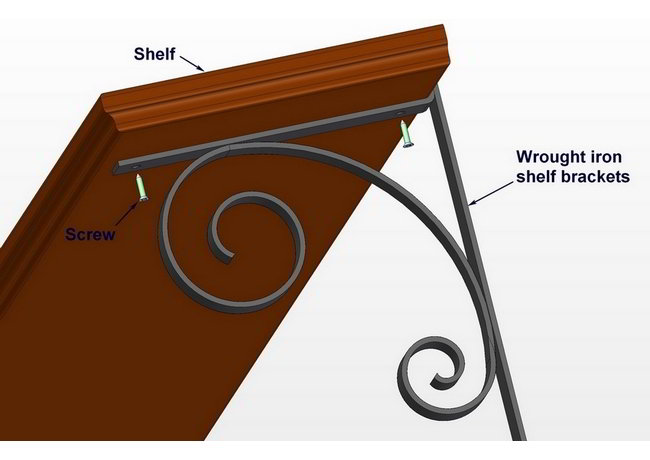
If you are into metal processing and welding, you can create beautiful shelf brackets from wrought iron in your workshop. This is a shelf hanging method that allows boundless creativity. Please type the following keywords into a search box: ’wrought iron shelf brackets’, and you will obtain a large number of both simple shelf brackets and those of exceptional design. A good thing is that if you don’t have any experience or the desire to design them yourselves, on the Internet you can find wrought iron shelf brackets of different sizes and designs and choose any to your liking.






































